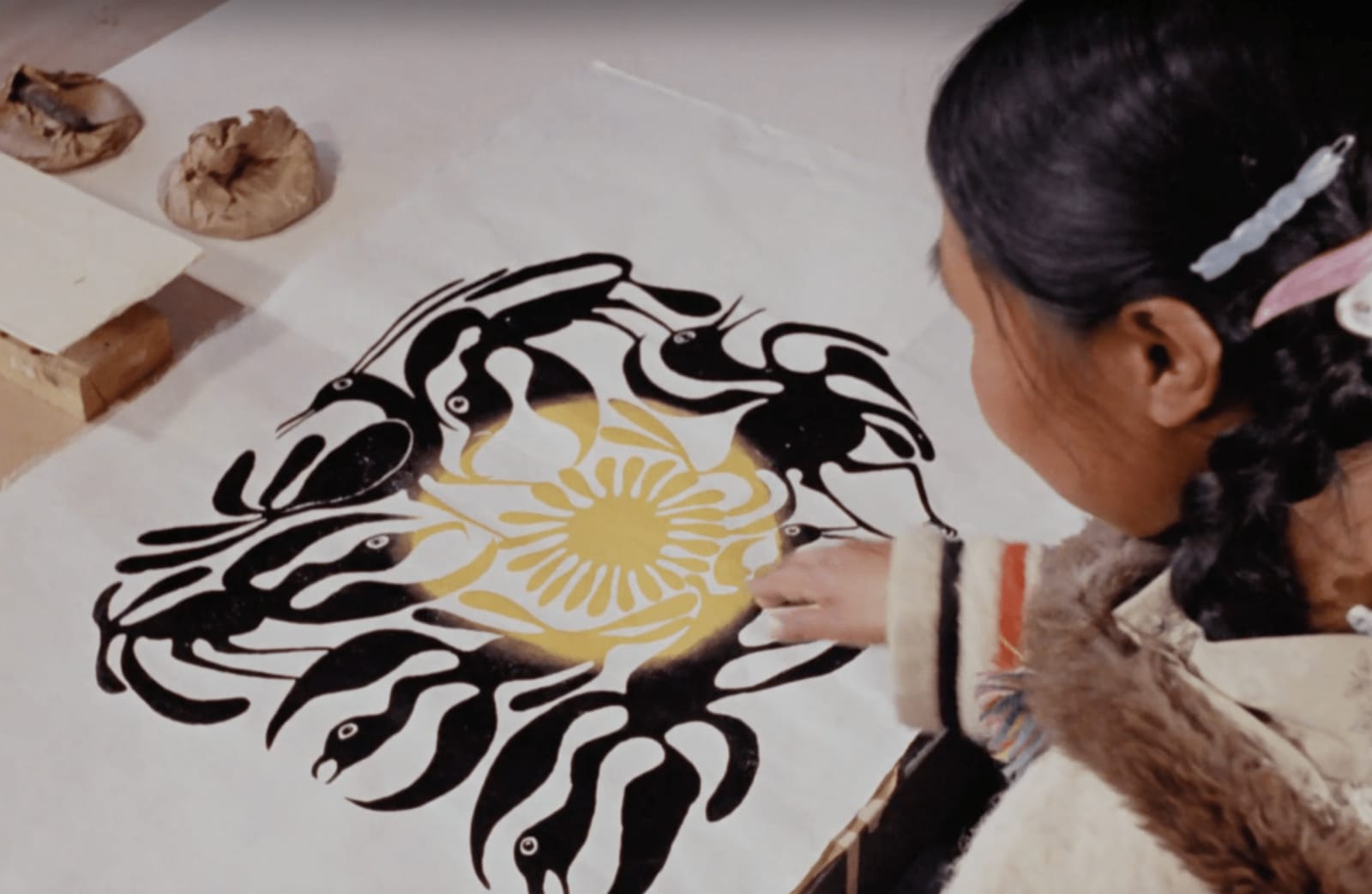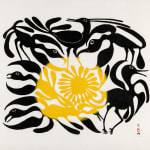-
Artworks
KENOJUAK ASHEVAK, C.C., R.C.A. (1927-2013) KINNGAIT (CAPE DORSET)
The Arrival of the Sun, 1962 #69Printmaker: LUKTA QIATSUK (1928-2004) KINNGAIT (CAPE DORSET)
stonecut, 25 x 32.25 (63.5 x 81.9 cm)
49/50LOT 58
ESTIMATE: $9,000 — $12,000
PRICE REALIZED: $24,400.00Further images
In 1963, Kenojuak Ashevak was the focus of the National Film Board's documentary, Eskimo Artist: Kenojuak [1]. This captivating 19-minute film provides viewers with a unique insight into the transformation...In 1963, Kenojuak Ashevak was the focus of the National Film Board's documentary, Eskimo Artist: Kenojuak [1]. This captivating 19-minute film provides viewers with a unique insight into the transformation of Kenojuak's graphite drawing for The Arrival of the Sun into a stone plate, and its subsequent printing in the workshop for eventual sale. Garnering an Oscar nomination and winning several awards, this documentary undeniably catapulted Kenojuak to stardom.
In a 1983 interview with Inuktitut magazine, Kenojuak reflected on the extraordinary and transformative impact the film had on her career. At the time of filming, while she could not have envisioned how the portrayal of her creative process for The Arrival of the Sun would catapult her to stardom, the income from the film provided her with unprecedented financial freedom. The funds enabled her husband Johnniebo, also featured in the film, to purchase a canoe from Lukta Qiatsuk. "For years,” Kenojuak shared, “Johnniebo had striven to achieve independence and now at last was able to hunt alone. It seemed like a new beginning for us" [2].
In the film, the roles of Iyola Kingwatsiak as the plate cutter and Lukta Qiatsuk as the printmaker are showcased, highlighting their indispensable contributions to the printmaking process. Intriguingly, until now, Iyola's role as the stonecutter has been conspicuously absent from the vast body of literature that has reproduced the print. In our dialogues with Sandra Barz, we acknowledge the regrettable lack of documentation from Kinngait's early printmaking days but it is both serendipitous and enthralling that new insights continue to surface and that we are able to contribute to deepening understanding and appreciation of this pivotal phase in the history of Inuit art [3]. Moreover, having the opportunity to view the film allows us to observe the transformations from Kenojuak’s original drawing to the final print. Notably, the central face in Kenojuak’s drawing, bearing a striking resemblance to The Woman Who Lives in the Sun, is absent in the printed version.
Beyond the impact that the making of this particular print had on Kenojuak’s life and career, its formal qualities are nothing short of mesmerizing. The Arrival of the Sun is a striking work which presents a composition that is a dance of fluid forms, marked by a boldness of colour. The depicted birds, rendered in curvilinear elegance, seem to embody movement and life associated with the return of the sun after the period of Polar Night. The birds flitter about and encircle a central sun, which bursts forth in a radiant yellow, as if in celebration of its warmth and return. This particular edition of the print has preserved the intensity of the yellow remarkably well, giving it a presence so potent that the sun’s warmth is not merely seen but almost felt.
We extend our gratitude to Sandra Barz for invaluable input when cataloguing this lot.
1. The National Firm Board notes the incorrect use of the word “Eskimo,” "an outdated and offensive term was formally rejected by the Inuit Circumpolar Council in 1980." It is important to note that colonial mythologizing is abundant in the film but the technical aspects are sound illustrations.
2. Kenojuak in “Autobiography”, Jean Blodgett, Kenojuak, (Toronto: Firefly Books / Mintmark Press Ltd., 1985) p. 22.
3. Correspondence with Sandra Barz, 25 March 2024. We extend our gratitude to Sandra Barz for invaluable input when cataloguing this lot.
References: See film Eskimo Artist: Kenojuak Ashevak on the NFB’s website: https://www.nfb.ca/film/eskimo-artist-kenojuak/ (Accessed 20 March 2024). Sandra Dyck in Atiqput: Inuit Oral History and Project Naming, [(sl: McGill-Queen's University Press, 2022), pp. 198-99.] discussed the film at length. Jean Blodgett also discussed the film in her publication Kenojuak, (Toronto: Firefly Books / Mintmark Press Ltd., 1985, p. 22). The full interview with Kenojuak regarding is in “lnuktitut Asks Kenojuak About Her Life as an Artist and Mother”, Inuktitut, January, 1983. pp. 8-16, parts of this interview, along with stills from the film, are reproduced in Inuit Art Quarterly, vol. 27, no. 1, Winter, 2014, pp. 16-21.
The Arrival of the Sun has reproduced in several important books on the artist and elsewhere, including but not limited to: Helga Goetz, The Inuit Print, international travelling exhibition, (Ottawa: National Museums of Canada and the Department of Indian and Northern Affairs, 1977), pl. 26, p. 78 and p. 6 in colour; Jean Blodgett, Kenojuak, (Toronto: Firefly Books / Mintmark Press Ltd., 1985), pl. 28, unpag.; Leslie Boyd Ryan, Cape Dorset Prints: A Retrospective, (San Francisco: Pomegranate, 2007), p. 61; Norman Vorano, Inuit Prints: Japanese Inspiration, (Gatineau: Canadian Museum of Civilization, 2011), cat. 28, p. 86; and Anna Hudson, Jocelyn Piirainen, & Georgiana Uhlyarik, Tunirrusiangit: Kenojuak Ashevak and Tim Pitsiulak, exh. cat., (Toronto: Art Gallery of Ontario, 2018), p. 57. Interestingly, on the cover of North / Nord Magazine, Vol., XV, no. 4, July/Aug 1968, an anthropomorphized sun appears on a design for gift wrapping paper that resembles the omitted sun from Kenojuak’s drawing for The Arrival of the Sun.
Provenance
Innuit Gallery, Toronto, their preserved label from the previously discarded frame, verso;
Private Collection, Toronto;
Estate of the above.
Join our mailing list
* denotes required fields
We will process the personal data you have supplied in accordance with our privacy policy (available on request). You can unsubscribe or change your preferences at any time by clicking the link in our emails.










